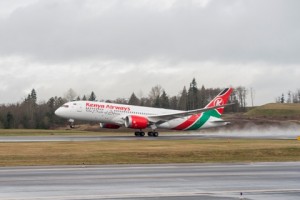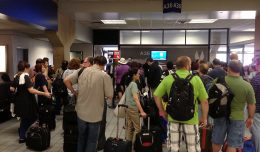Being a pilot in Africa, one of the questions that is frequently heard from time to time is, “Is this thing safe?” This is due in part because in the passenger’s eyes it is a small aircraft, but also because they’re flying on an airline in Africa. Most of the passengers that are seen here arrive on South African Airways, which was ticketed through their travel agent thus to them meaning it is safe. But what is safe in Africa? And are there things to actually be concerned about if travelling around the continent or even on one of its airlines who seem to have an ever-growing number of 5th freedom routes around the world?
According to the Aviation Safety Network, 2013 was a great year for aviation safety with only 29 fatal airliner accidents worldwide. However Africa was deemed the least safe continent accounting for one-fifth of all fatal airliner accidents. While aviation safety still has a lot of room for improvement in Africa as whole, it is unwise to assume the entire African aviation landscape is all the same. First of all Africa is huge, so lumping the entire continent into a statement like “Africa is unsafe” is a bit uncalled for. Yes, there are parts of the continent that have near constant civil wars, bad aviation infrastructure and are generally unsafe for tourists, but there are also plenty of others that have very strong tourist infrastructure with all the modern – albeit in some cases just basic – amenities that a western tourist would look for. Most of the airlines in the more developed parts of Africa have learned that they cannot depend on old aircraft with old management styles and have started moving forward, in some cases quite rapidly. If you simply look at the major airline alliances of the world you will see them having members such as Egypt Air, Ethiopian Airlines, Kenya Airways and South African Airways. These and many others are leaders in their respective country’s aviation industry and all take safety seriously.
There are a growing number of safety oversight groups forming on the continent, such as the Africa Aviation Safety Council (AFRASCO) which was formed in 1989 to begin addressing the increasing safety concerns in Africa. Today AFRASCO has numerous members, mainly from Eastern and Southern Africa, including companies such as Airports Company South Africa, Comair, Ethiopian Airlines, Egypt Air, and Kenya Airways.
A few years ago the International Civil Aviation Organization (ICAO), a division of the United Nations, met to begin a strategic action plan to increase aviation safety in Africa. Part of the plan was to increase transparency in the safety organizations in each country, which plays a large part in safety. This is primarily because in the past employees would feel threatened if they addressed a safety concern, possibly out of fear of reprisal from the management of their company. This is something that is rapidly changing across the continent as employees are being given methods to anonymously report safety concerns to a safety officer who acts outside of the management of the company, and who can address these concerns in a private forum.
ICAO also has recommended that all African carriers go through an IATA (International Air Transport Association) Operational Safety Audit, or IOSA. This is an audit that carriers around the world are required to go through, even in fully developed countries such as the United States, and is a major step to bringing many of the smaller companies in Africa to the front lines of the safety standards in place in the rest of the world.
Another item to consider when it comes to the safety of a large number of the air operators flying in Africa are their crews. Many of the airlines hire foreign pilots to either fly on the line, or fly as instructor pilots on multi-year contracts, those that do typically hire pilots who are from their home country but that have been trained in Europe or the USA and have FAA or JAA licenses. Speaking from experience here myself, when I was an instructor in the USA I was working at a flight school that specialized in training foreign pilots. Two of my students were from Nigeria and had been given an opportunity to train in the USA for their FAA certificates before returning to Nigeria to take up employment with one of the many companies flying there, bringing with them the level of training that most in the world would expect from the FAA.
Going back to the question of “Is this thing safe?” that is occasionally heard from passengers, think about that question for a moment. It is generally asked in a light hearted manner but at the same time there a hint of tension in the passenger’s voice as they ask it. Pilots are pilots for one reason, their love of the job and no pilot in their right mind is going to knowingly put passengers on an aircraft that is unsafe. I for one would never consider it, I’m happier grounding the aircraft than flying it if it is unsafe.

Major African airlines have begun acquiring new fleet types, such as this Kenya Airways 787. (Photo: Boeing)
One big misconception that should also be addressed is that the age of the aircraft has something to do with safety. While older machines do typically have more issues, these issues are usually more minor than on your own car due to the fact that we have more rigorous maintenance schedules than your personal car, and are maintained by more highly qualified mechanics than your own car. Along with that, how often do you perform a through inspection of your car before you get in and drive off to work? If you look at most of the modern African airlines that I mentioned earlier, you’ll see that they are in the midst of massive fleet renewal programs that include adding aircraft such as the 777, 787 and A330 to the fleet to replace some of the older frames, so chances are your flight will be flown by a relatively new aircraft.
Despite what you see on TV, Africa is generally a safe destination, provided you stick to the normal tourist trail in most of the countries. Of course there are some countries such as Botswana, Namibia and South Africa that allow you to get off the beaten path and really explore. Now is the time to book the trip and get out there and see what this amazing continent has to offer, but be smart and use common sense and everything will be fine.
Ryan Gaddis started his aviation career in 2001 and worked in airline customer service, operations, and served as a loadmaster for nearly 10 years before returning to flight school to complete his flight training in 2012. He has since worked as a certified flight instructor in the United States before moving to Namibia to fly the bush.







